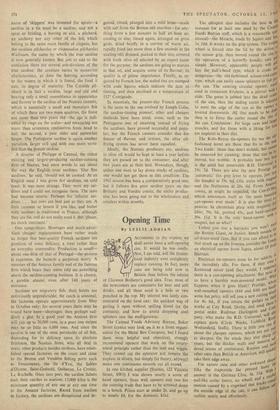Opening Time
By LESLIE ADRIAN
ACCORDING to the experts we shall never have a self-opening can. It would be too costly. Nor, I am told, will the frozen- food industry ever completely replace canning. In fact, more cans are being sold now in Britain than before the advent of Clarence Birdseye's good idea. True, most of the newcomers are containers for beer and soft drinks, and all these need is a hole or two punched in the top. My interest was lately con- centrated on the food can: the quickest way of getting it open without spilling blood (or the contents); and how to avoid dropping steel splinters into the mulligatawny.
The Canned Foods Advisory Bureau, Baker Street (cynics may look on it as a front organi- sation for the Metal Box Company, but I found them most helpful and objective), strongly recommend openers that work on the rotary- wheel principle rather than the stab and wiggle. They cannot cut the operator nor remove the tinplate in slivers, but simply (in theory, anyway) make one continuous smooth cut all round.
In one kitchen supplier (Staines, 122 Victoria Street, SW1) I was shown nearly a score of hand openers, three wall openers and two for the catering trade that have to be screwed down to a bench. Prices start at under 2s. and go up to nearly £4, for the domestic kind.
instance (or at least one used by the Cat1041 Foods Bureau staff, which is a reasonable testa' mania') —the Miracle, made by Squire and Son' ls. 10d. It works on the grip system. The cutting. The cheapest also includes the best in Oil wheel is forced into the lid by the action the scissor grip, then moved round the riot II; the operation of a hutterfly handle; safe an simple. However, apparently people will still buy the bull's-head type, which is crude anj' dangerous—the old-fashioned scissor-and-cutter type, which can easily cause splinters to fall 1st° the can. The catering circular opener, iriu6i used in restaurant kitchens, is a piercer with slide. The point is jabbed into the dead colt°, of the can, then the sliding cutter is adjusted to meet the edge of the can as the °Paler: is levered downwards. All that needs to be then is to force the cutter round the rim ". the can. Conclusion: for large cans and target muscles, and for those with a liking for iron (or tinplate) in their diet.
old'
The Rolls-Royce tin-openers (to use the fashioned term) are those that fix to the Iv' Two kinds: those that don't wobble, but can be removed for cleaning; those that can be re.c moved, but wobble. A probable best buY belt is the solid but removable R.D. Universal; 19s. 3d. There are also the new Prestige go `automatic' (no grip lever to operate, lust turd the handle) at 39s. 6d. (10s. extra with magnet) and the Nutbrown at 26s. 6d. From America comes, as might be expected, the Can-0-1V1.,3.i which announces itself as 'the most beau s can-opener ever made.' It is also the most e, Harrods. magnetic pensive. In chromium plate with m aten lifter, 79s. 9d., painted 45s., and hand-Oper 3 39s. Ild. It is the only hand-opener With magnet, but so what? need Unless you run a barracks you Won for the Bonzer Giant, or Junior, bench models be oil-drum-sized cans. But if you can afford to of, that much up on the Joneses, consider the l'efflofit an electrical opener from Japan, about £8 'r is or Electrical tin-openers must be for addicts' $ the incredibly idle. For them, if they °Wollso, Kenwood mixer (and they would, suPP there is a can-opening attachment. But m°51; us have a humble man-powered model. whose happens when it goes blunt? Prestige, - ad, wall-mounted openers (844 and 848) are j some but pricy, will sell you a new cattinsg,,sythbeee.:,. for 4s. 6d., if you return the gadget works at City Road, Derby, and send ilicerilor' postal order. Rudimer Darlington and alb pany, who make the R.D. Universal, will a replace parts (Clyde Works, Lichfield Road au d° Wednesfield, Staffs). There is little you c co about the cheaper openers, which are not {at to sharpen. On the whole they stay sharp soi, years, but the thicker walls and massivernost dered seams of continental, Russian and oy other cans than British or American, will cluic take their edge away.d shaPe' (like the trapezoids for pressed had Fors quare cans and other awkwar ) thf With 0
Wit
answer is the German Clou, 4s, 11d. ratchet nail-like cutter (sorry, no wheel) and 3 Oh .
" '
motion caused by a cogwheel that tracks w 0) the outside edge of the can, it can follow II outline neatly and effortlessly.






































 Previous page
Previous page